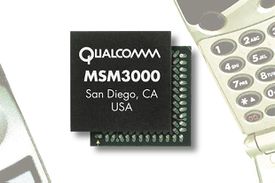| (One intermediate revision by the same user not shown) | |||
| Line 33: | Line 33: | ||
| successor 2 link = qualcomm/msm5000 | | successor 2 link = qualcomm/msm5000 | ||
}} | }} | ||
| − | '''MSM3000''' ('''Mobile Station Modem 3000''') was a fifth generation family of {{arch|32}} [[ARM]] mobile [[system on chip]]s with [[IS-95]] (cdmaOne) capabilities designed by [[Qualcomm]] and introduced in [[1998]]. This chip marked a significant departure from all their previous generation of chips by switching to an [[ | + | '''MSM3000''' ('''Mobile Station Modem 3000''') was a fifth generation family of {{arch|32}} [[ARM]] mobile [[system on chip]]s with [[IS-95]] (cdmaOne) capabilities designed by [[Qualcomm]] and introduced in [[1998]]. This chip marked a significant departure from all their previous generation of chips by switching to an [[ARM]]-based ({{armh|ARM7TDMI}}) core. Previously Qualcomm was using an embedded {{intel|80186}} by [[Intel]]. This family was developer in parallel to the {{\\|MSM5000}} family which was based on the {{\\|CDMA2000}} standard. |
== Overview == | == Overview == | ||
Latest revision as of 14:56, 4 July 2017
| Qualcomm MSM3000 | |

| |
| Developer | Qualcomm |
| Type | System On Chips |
| Introduction | September 24, 1998 (announced) December 1998 (launch) |
| Architecture | CDMA/FM system-on-a-chip |
| ISA | ARMv4 |
| µarch | ARM7TDMI |
| Word size | 32 bit 4 octets
8 nibbles |
| Technology | CMOS |
| Package | QFP |
| Succession | |
| ← | → |
| MSM2300 | MSM3100 MSM5000 |
MSM3000 (Mobile Station Modem 3000) was a fifth generation family of 32-bit ARM mobile system on chips with IS-95 (cdmaOne) capabilities designed by Qualcomm and introduced in 1998. This chip marked a significant departure from all their previous generation of chips by switching to an ARM-based (ARM7TDMI) core. Previously Qualcomm was using an embedded 80186 by Intel. This family was developer in parallel to the MSM5000 family which was based on the CDMA2000 standard.
Overview[edit]
In mid-1998 Qualcomm announced that they've acquired a license for ARM7TDMI. The switch upgraded their SoC from a 16-bit (which was previous based on Intel's 80186) to a 32-bit ARM (implementing the ARMv4 instruction set). The switch had big impact on the chip - die size was decreased, power consumption was significantly reduced, and performance was increased. MSM3000 offered data rates of up to 86 Kibit/s
Members[edit]
| Part | Description |
|---|---|
| MSM3000 | SoC |
| IFT3000 | Transmit IF Converter |
| IFR3000 | Receive IF Converter |
Documents[edit]
| designer | Qualcomm + |
| first announced | September 24, 1998 + |
| first launched | December 1998 + |
| full page name | qualcomm/msm3000 + |
| instance of | system on a chip family + |
| instruction set architecture | ARMv4 + |
| main designer | Qualcomm + |
| microarchitecture | ARM7TDMI + |
| name | Qualcomm MSM3000 + |
| package | QFP + |
| technology | CMOS + |
| word size | 32 bit (4 octets, 8 nibbles) + |